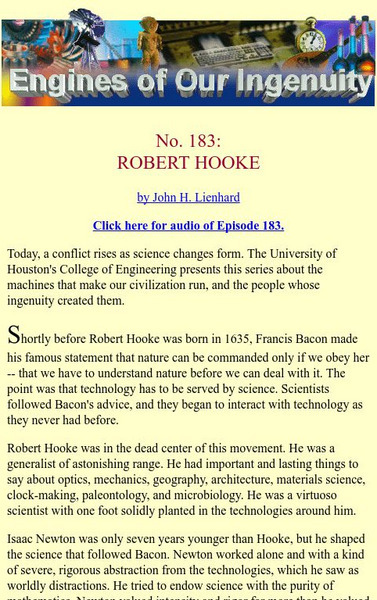Hi, what do you want to do?
Curated OER
Archeological Finds
Young scholars explore archeology and it contributions to human history. They write a magazine article describing the discovery of a dig.
Curated OER
Footprint Detectives: Making Inferences Using Dinosaur Trackways
Students analyze and discuss footprints and dinosaur tracks. They listen to books about paleontologists, create and analyze their own trackways using black paper and chalk, examine the data, and form hypotheses about footprints and...
Curated OER
Hide and Seek with Bones: A Mapping and Scaling Comparison
Students examine and simulate how paleontologists map objects. They hide and find objects using a grid to map the objects' placements.
Curated OER
Animal Tracks - Walking and Running
Students, using paper and water, make tracks and record the time needed to make them. They compare tracks made walking and running to determine the speed of the animal.
Curated OER
Chesapeake Bay Fossils/Geology
Students define and investigate paleontology, research geological history of the Chesapeake Bay, review geological time line, and identify fossils of the Chesapeake Bay.
Curated OER
White Glue Fossils: Casts, Molds, and Impressions
Students make impressions and molds in clay and them make casts with glue. After the glue dries students remove their fossils.
Curated OER
Types of Dinosaurs
Young scholars complete puzzles of dinosaurs. They compare each piece of the puzzle to a fossil and simulate a scientist's role in learning about dinosaurs.
Curated OER
Fossils
Students act as paleontologists to discover who a mystery guest to the classroom was. They do not know the identity of the guest but infer the identity from items left behind in the classroom. They make inferences from dinosaur fossils.
Curated OER
Cookie Paleontologists
Students become cookie paleontologists. In this paleontology lesson, students try to excavate whole chocolate chips from a chocolate chip cookie without breaking the cookie. They use toothpicks and paintbrushes to do it.
Curated OER
Branches of Science
In this science instructional activity, students locate and identify the various branches of science as they are named. There are 36 words/phrases located in the puzzle.
Curated OER
Biology: Howler Monkeys Tell All
Students examine a PBS special about howler monkeys as an introduction to scientific forensic investigative methods. In groups, they conduct a host of experiments containing clues which point to discovery. By challenging assumptions,...
Curated OER
Excavation Dig
Young scholars engage in a role-play of a dinosaur excavation dig. They dig through sand to locate buried bones and then discuss the ethics of destroying buildings and other property to get at the fossil remains.
Curated OER
Dig It!
Second graders complete various activities about dinosaurs and fossils. They conduct Internet research, participate in a sandbox dinosaur fossil dig, and create a computer slideshow presentation using information they found on various...
Curated OER
Dig This
Fifth graders explore the work of paleontologists and the life of dinosaurs and create a sculpture of the bones of a Stegosaurus. The sculpture was then buried and used by other classes for a dig.
Curated OER
Introduction to Paleontology Lab
Students engage in a lab which introduces them to fossils and paleontology. They examine eleven numbered boxes containing fossils which are related to the questions on this lab then answer questions on a lab sheet imbedded in this plan.
Curated OER
Dino Traces
Pupils are introduced to the type of evidence that is found at a typical dinosaur dig. They create rubbing casts of bone impressions on paper and, using bones, identify dinosaurs.
Curated OER
Can You Dig It?
Young scholars investigate a fossil site and diagram a site map. They role play as paleontologists.
Curated OER
Be a Paleontologist
Learners search for fossils in a simulated archeology site and explore how paleontologists mark out a dig site.
Curated OER
Where Can I See The Sea?
Learners see how the pieces of the fossil puzzle fit together to allow the paleontologist to imagine the earth as it was millions of years ago. They draw a map showing what environments were present in a certain area more than 70 million...
PBS
Pbs Learning Media: Whales in the Making
This graphic from Evolution, traces the evolution of whales from land-dwelling mammals to the aquatic creatures we know today. A PDF is included that diagrams the evolutionary process that is believed to have taken place.
University of Houston
University of Houston: Engines of Our Ingenuity: Robert Hooke
The transcript of a talk given on the syndicated radio broadcast titled "The Engines of Our Ingenuity." Interesting account of Robert Hooke. Using a captivating and engaging story line, the article tells of Hooke's many interests in...
University of California
Ucmp: A Relative Dating Activity
An learning activity to help students grasp the concept of relative dating and geologic time.
Smithsonian Institution
Smithsonian Learning Lab: Digging Up Dirt: How Paleontologists Bring Dinosaurs Back to Life
Teachers can download this teaching package that introduces students to the science of paleontology. Fossil formulation and details about the work of paleontologists are discussed. Find out how paleontologists discover, stabilize, and...
Other
Denver Museum of Nature and Science: Follow a Fossil
Students examine paleontology, the study of ancient life on Earth. Some topics explored are vertebrates, invertebrates, and plants.


























